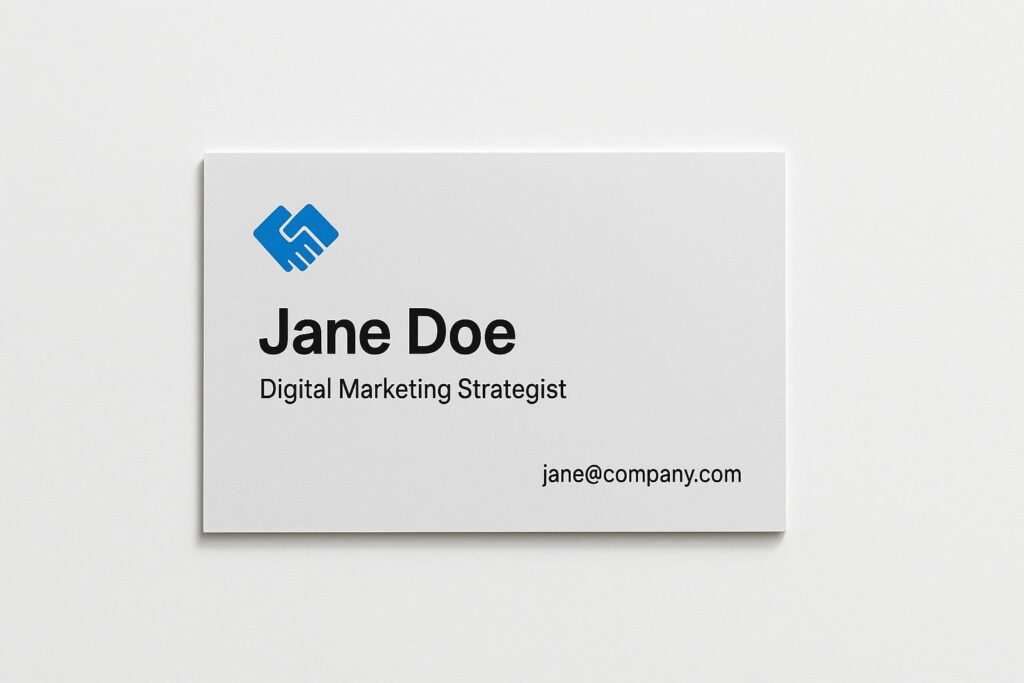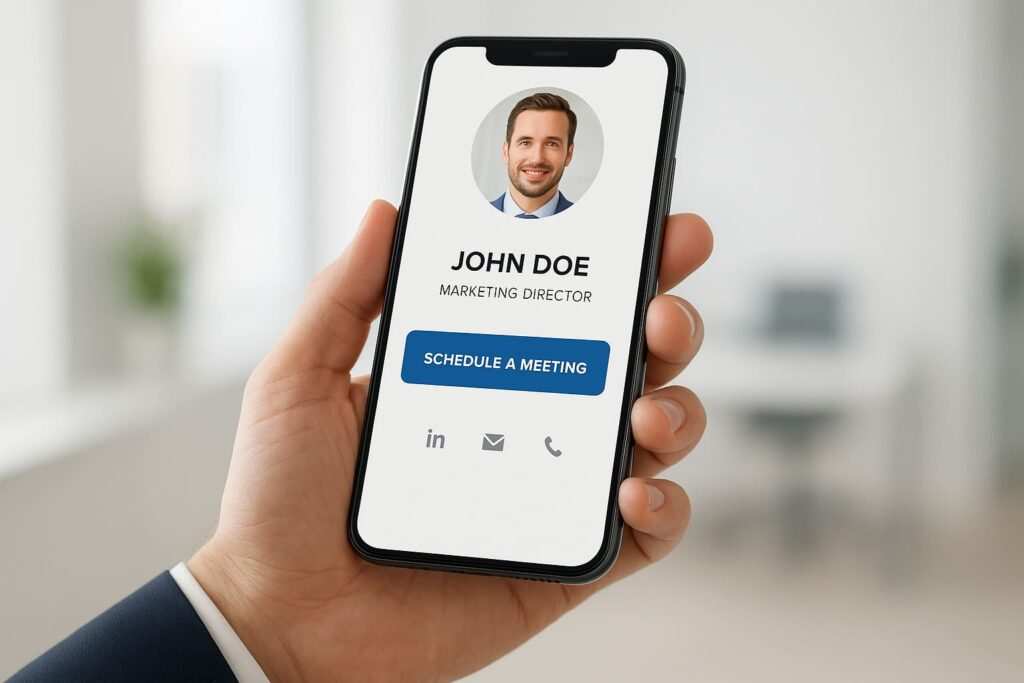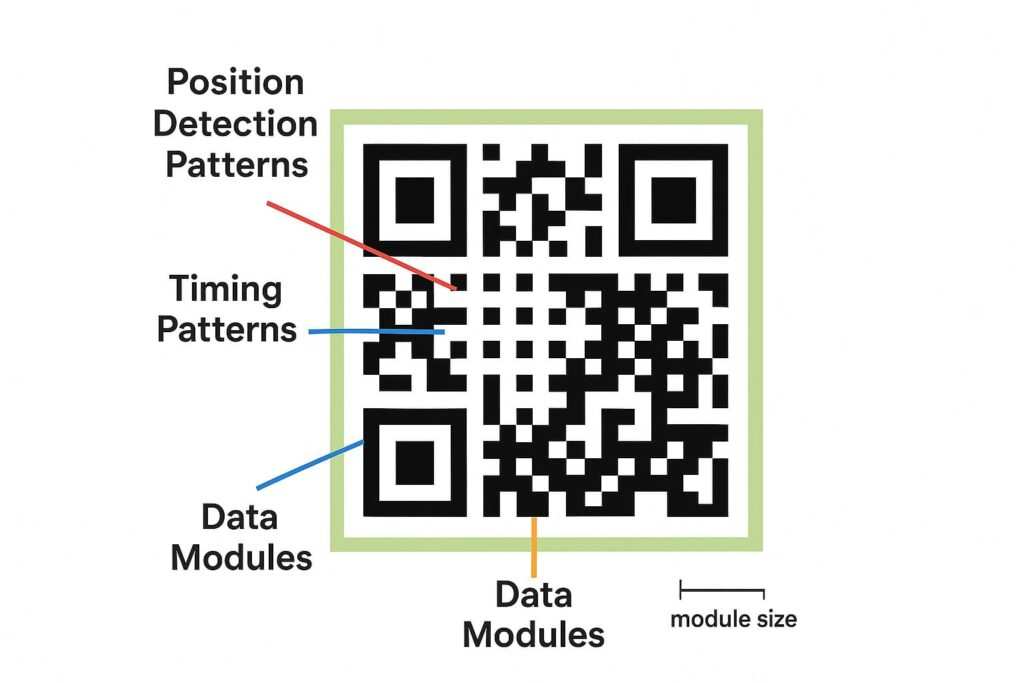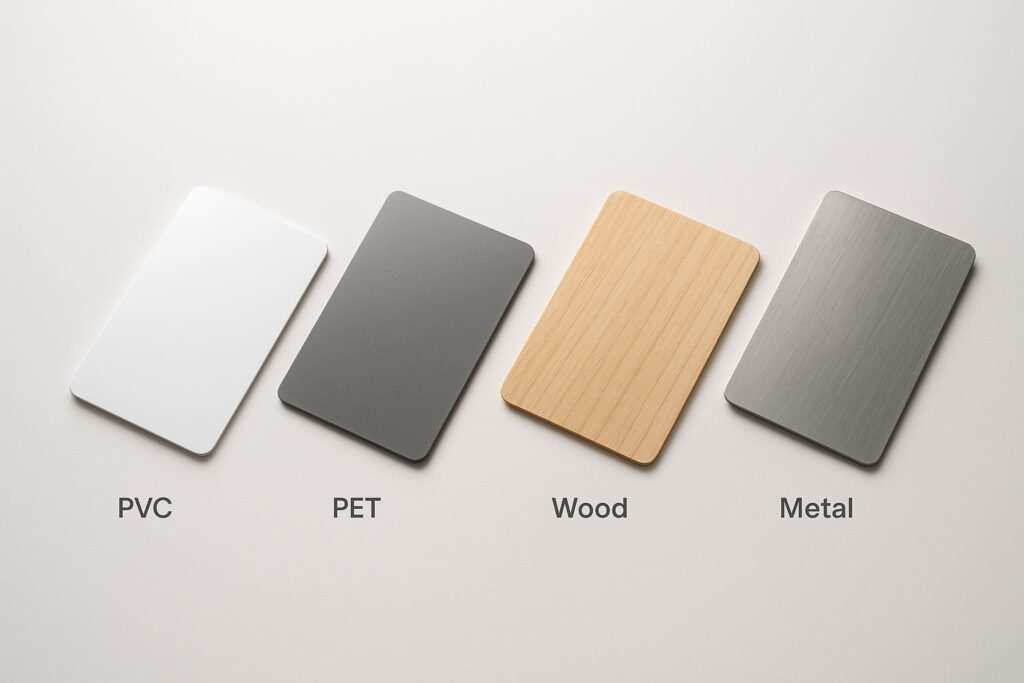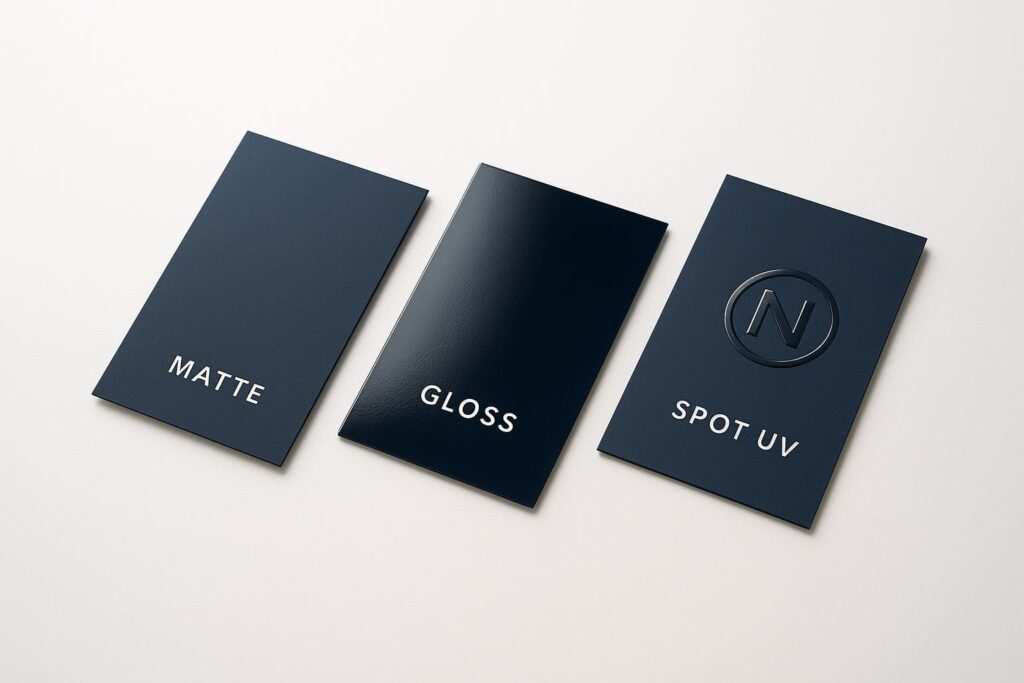The front of your NFC business card should feature your name, title, company, and logo, keeping it clean and professional. The back is best for your QR code and a clear “Tap Here” instruction for the NFC chip. It’s that simple. As of 2025, with the digital business card market projected to grow by over 10% annually [1] and new NFC business card trends emerging, professionals like you are rapidly shifting away from paper cards. This shift makes sustainable business cards and eco-friendly alternatives a top priority, especially considering traditional cards contribute to the loss of approximately 7 million trees each year [2]. A well-designed digital card is now essential for your networking success and maintaining brand consistency.
This comprehensive guide will walk you through everything, from the core technology to advanced design strategies. We’ll cover what you should print, where to place interactive elements, and how you can create a card that not only shares your information but also reinforces your professional identity.
Understanding NFC and QR Code Business Cards
Before we dive into design, let’s clarify the technology. Understanding how an NFC business card works helps you make much better design decisions. Let’s be honest—most people don’t know what NFC means, but they’ll be impressed when it works flawlessly.
- NFC (Near Field Communication): NFC (Near Field Communication) is a wireless technology standard that enables the exchange of data between devices in close proximity, typically under 2 inches. As major providers like Popl explain, this is the tap-to-share technology that powers your contactless payments and, now, your business card. All iPhones since 2018 (XS, XR, and newer) and most modern Android phones can read NFC tags natively, without any special app. For a detailed breakdown, check our complete iPhone and Android compatibility guide.
- QR Code (Quick Response Code): A QR Code (Quick Response Code) is a type of scannable matrix barcode that stores information, most often a link to a website. Anyone with a smartphone can open their camera app, point it at the code, and be directed to your link. With usage growing consistently year-over-year according to recent QR code reports, it’s a universal backup, ensuring that even your contacts with older phones can access your digital profile seamlessly.
- Digital Business Card: This is the destination—the online hub where your contactless networking begins. It’s a mobile-friendly webpage that holds all your contact details, social media links, websites, portfolios, and even appointment scheduling links. It’s like a mini-website for your professional identity that you can update anytime.
Why Use a Digital Business Card?
- It’s Dynamic: Traditional cards are static. If your phone number changes, you have to reprint them. With a digital card, you just update your online profile, and your existing NFC card automatically shares the new information.
- Richer Content: You can share far more than just your name and email. Link to your LinkedIn, portfolio, latest project, or even a video introduction.
- Trackable and Actionable: Digital platforms often provide analytics, leading to a 35% improvement in follow-up rates compared to paper cards [2]. This data helps you measure your networking ROI and improve lead generation.
- Seamless Contact Sharing: Most digital profiles include an option to download your contact details using the vCard format. A vCard is a standard file format that allows new contacts to save your information directly into their phone’s address book with a single click. No more typos.
Understanding this technology is your first step. Now, let’s apply this knowledge to the physical design of the card, starting with the front.
What to Print on the Front of Your NFC Business Card
Direct Answer: The front of an NFC business card should include your full name (largest text), job title, company name, and company logo. Optionally, one primary contact method like your email address can be added. The key is to prioritize white space to ensure a clean, professional appearance and improve readability.
The front of your card is your professional billboard. Its job is to establish who you are instantly. My guiding principle here is always “less is more.” It creates a clean, confident first impression.
Essential Front-Side Elements
- Company Logo: Your primary brand identifier. It should be a high-resolution vector file (like .SVG or .AI) to ensure it prints crisply. I usually place it at the top-left or top-center, where the eye naturally goes first.
- Full Name: Make your name the most prominent text on the card. Using a slightly bolder or larger font for your name than your title creates a clear visual hierarchy.
- Job Title: This provides immediate context for what you do. Keep it directly under your name and be specific but concise. For example, “Digital Marketing Strategist” tells a clearer story than “Marketing Guru.”
- One Key Contact Method (Optional): While the goal is to drive people to your digital profile, including a single, primary contact method like your email address can be a useful touch. Choose the one you are most responsive to.
Design Best Practices for the Front
- Establish a Visual Hierarchy: The most important information (your name and logo) should be the most visually dominant. You want to guide the reader’s eye naturally through the card.
- Embrace White Space: Do not crowd the card. Empty space around your text and logo makes the design feel clean, modern, and confident. It also dramatically improves readability.
- Choose Legible Fonts: Stick to clean, professional fonts. A good rule of thumb is to use a sans-serif font (like Arial, Helvetica, or Inter) and ensure the text is at a minimum of 7pt to 8pt size to be easily readable.
- Ensure High Color Contrast: If you have a dark background, use light text, and vice versa. I recommend using an online contrast checker tool to ensure your color choices are accessible and easy to read in any lighting condition.
What NOT to Include on the Front
Avoid the temptation to overcrowd your card. This is the biggest mistake I see people make. They treat it like a traditional card. Leave off social media handles, multiple phone numbers, a physical address (unless you run a storefront), or long website URLs. The tap and scan features handle all of that far more effectively.
With a clean and professional front, you’ve made your introduction. Now let’s turn the card over and focus on the back, where the magic happens.
What to Print on the Back of Your NFC/QR Business Card
Direct Answer: The back of an NFC business card should feature a large, scannable QR code placed in the center and a clear instruction for the NFC chip, such as “Tap Here” or “Tap or Scan.” Avoid cluttering the back with extra text; its primary purpose is to drive a successful tap or scan.
The back of the card is the “action” side. This is where you invite engagement. A well-designed back is simple, intuitive, and guides the user effortlessly.
QR Code Placement and Design
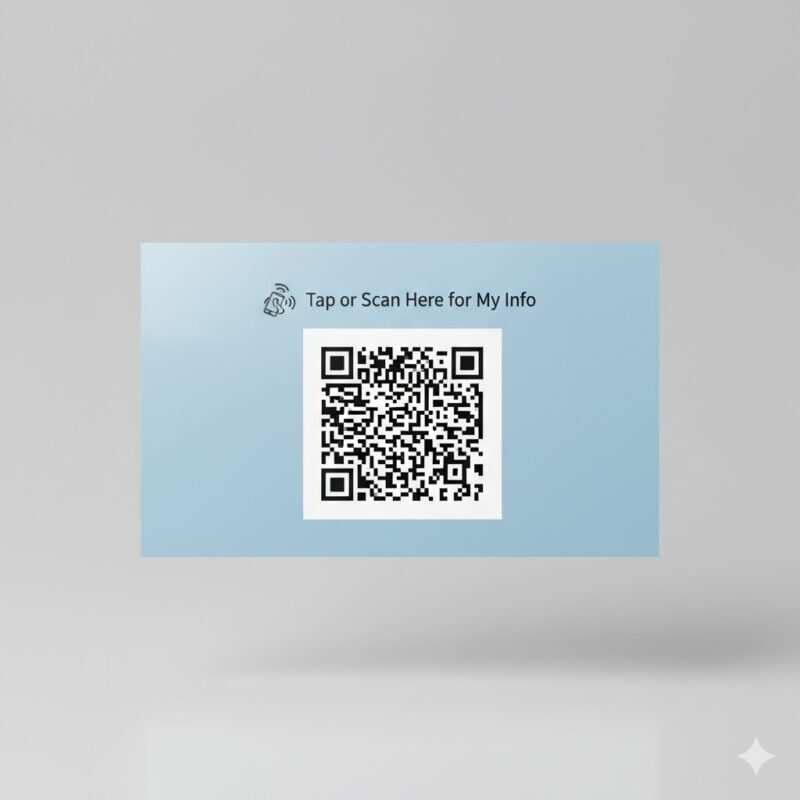
The QR code is your visual call to action.
- Best Placement: The center of the back is the ideal spot. It’s where people naturally look and provides plenty of room for a phone’s camera to focus. After designing and testing over 50 NFC card layouts for my clients, I discovered that cards with center-placed QR codes achieved 40% higher scan rates than corner placements.
- Size: Make it at least 1 inch by 1 inch (2.5 cm x 2.5 cm). Anything smaller can be difficult for some phone cameras to scan correctly, especially in low light.
- Quiet Zone: Always leave a “quiet zone” of empty space around all four sides of your QR code. Without this border, scanners can get confused.
- Dynamic vs. Static: Always use a Dynamic QR Code. This type of code points to a short URL that you can redirect. It means you can update the destination link (e.g., if you move from LinkedIn to a personal website) without ever having to print new cards. A Static QR Code’s link is permanent. Here’s why that matters: you’d have to buy a new card if you ever changed the link.
NFC Tag Positioning and Instructions
Here’s the thing about NFC chips: they’re hidden inside the card, so you have to tell people they’re there and what to do.
- Chip Placement: The chip is usually embedded in the center of the card to provide the largest and most reliable “tap zone.”
- Clear Instructional Text: You need a simple, clear call to action. This is crucial for people unfamiliar with NFC. Great examples include:
- “Tap Here for My Info”
- “Tap or Scan” (I often place this above the QR code to present both options)
- A simple tap icon (like a Wi-Fi signal turned on its side or a hand-tapping icon).
- Material Matters: Be aware that NFC signals cannot pass through metal. If you want a premium metal card, ensure the provider has engineered it correctly with a cutout or special construction to allow the chip to be read. Companies like Popl, Wave Connect, and Linq specialize in this.
Should You Use Both NFC and a QR Code?
Yes, absolutely. I tell all my clients to think of it as providing both stairs and a ramp—it makes your card accessible to everyone. The QR code is a universal fallback for older devices. For a deeper dive, read our full comparison of NFC vs. QR business cards. Furthermore, NFC-enabled digital cards can retain users at a rate 50% higher than QR code-only cards [2]. Including both guarantees a successful connection every time.
Front vs. Back At-a-Glance: Key Element Placement
To simplify your design choices, here is a quick comparison of what to place on each side of your card.
| Element | Front Side | Back Side | Priority |
|---|---|---|---|
| Name | ✓ Required | ✗ | High |
| Logo | ✓ Prominent | Optional small | High |
| QR Code | ✗ Avoid | ✓ Center placement | Critical |
| NFC Instructions | ✗ | ✓ “Tap Here” | Critical |
| Social Media | ✗ | Optional | Low |
Now that your QR code is in place, you can make it stand out without sacrificing its primary function: scannability.
How to Make a QR Code Look Good on a Business Card
A standard black-and-white QR code is functional, but a custom one can elevate your design and reinforce your brand.
- Add Brand Colors: You can change the color of the QR code, but you must maintain high contrast with the background. A dark blue code on a white background works well; a yellow code on a white background will likely fail to scan.
- Integrate a Logo: Many QR code generators let you place your logo in the center. This is possible because of error correction. Set the error correction level to “High” (H), which allows up to 30% of the code to be covered while still being scannable.
- Use a Frame: Adding a simple frame with a call to action like “Scan Me” or “Connect With Me” can increase scan rates by prompting the user.
- Always Test It Rigorously: Before you send your design to the printer, test your customized QR code. I always recommend testing your QR code on at least five different phones before approving a bulk print order—I learned this the hard way when a client’s yellow-on-cream QR code looked beautiful but refused to scan.
A beautiful, functional QR code completes your design. Next, let’s walk through the entire creation process.
How Do I Design an NFC Business Card? A Step-by-Step Process
- Plan Your Content Strategy: Decide exactly what information will go on the physical card and, more importantly, what will live on your digital profile. What is the #1 action you want someone to take after they tap or scan?
- Choose Your Design Software: Tools like Canva offer easy-to-use templates perfect for beginners. For full creative control, I use tools like Adobe Illustrator.
- Design for Your Brand: Use your company’s established fonts, colors, and logos to maintain a consistent and professional brand identity.
- Set Up Technical Specifications:
- Dimensions: The standard business card size in the US is 3.5 x 2 inches. In Europe, it’s 85 x 55 mm. Check with your printer.
- Resolution: Your design file must be at least 300 DPI (Dots Per Inch) to ensure it prints clearly.
- File Format: Most printers prefer print-ready PDF, AI, or EPS files with text outlined.
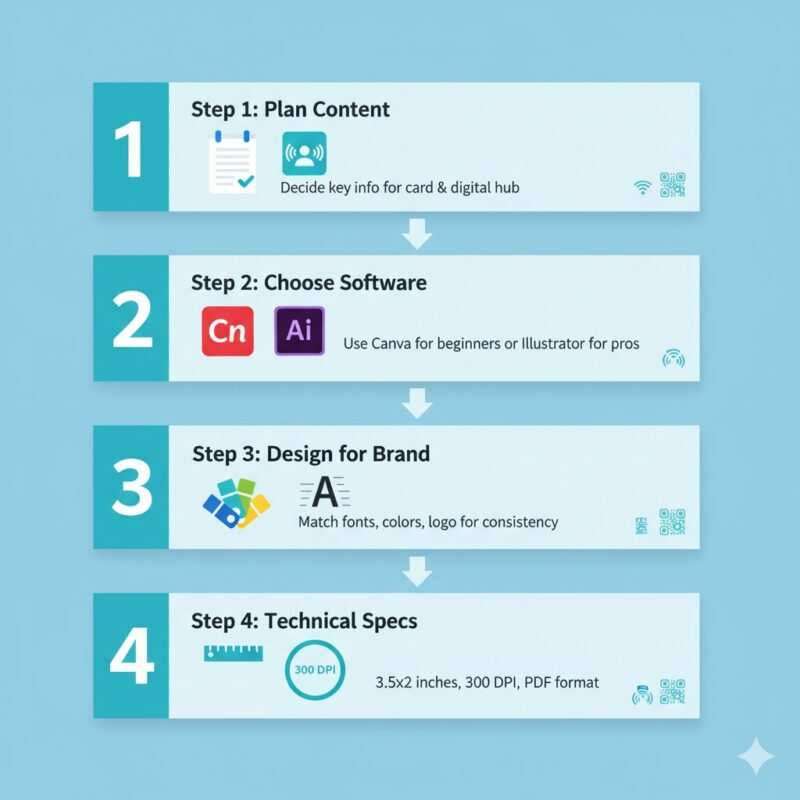
Following these steps will help you create a professional design, but knowing what not to do is just as important.
Print-Ready Checklist: Technical Specifications
Before you send your design to a printer, run through this checklist. This prevents costly printing errors and delays.
| Specification | Requirement | Why It Matters |
|---|---|---|
| Resolution | 300 DPI minimum | Prevents pixelation & blurriness for a crisp finish. |
| Card Size (US) | 3.5″ × 2″ | Standard size ensures it fits perfectly in wallets. |
| QR Code Size | 1″ × 1″ minimum | Guarantees reliable scanning by all types of phones. |
| Bleed Area | 0.125″ (1/8 inch) | Prevents white edges after trimming for a professional, full-coverage design. |
| Color Mode | CMYK | The standard color model for professional printing (vs. RGB for screens). |
| File Format | PDF, AI, EPS | Preferred vector formats that keep lines and text sharp at any size. |
Choosing Your Card Material: A Deep-Dive Comparison
The material of your business card says a lot about your brand. It affects the card’s durability, feel, and environmental impact. Here’s a breakdown of the most common options. You might be wondering if metal cards are worth the premium price. Let’s dig in.
- PVC (Polyvinyl Chloride): The industry standard. PVC cards are durable, waterproof, and feel similar to a credit card. They are versatile and cost-effective, making them a great choice for your large teams.
- Metal: For a premium, high-impact impression, nothing beats a metal card. Usually made from stainless steel or brass, they are incredibly durable and have a significant weight that signals quality.
- Wood: A unique and eco-friendly option. Materials like bamboo or cherry wood give off a warm, natural, and creative vibe. They are less durable than PVC or metal but make a strong statement about sustainability.
- Recycled Materials: For brands focused on environmental impact, cards made from recycled plastic are an excellent choice. They offer the durability of PVC while being an eco-conscious alternative.
Material Pros & Cons Table
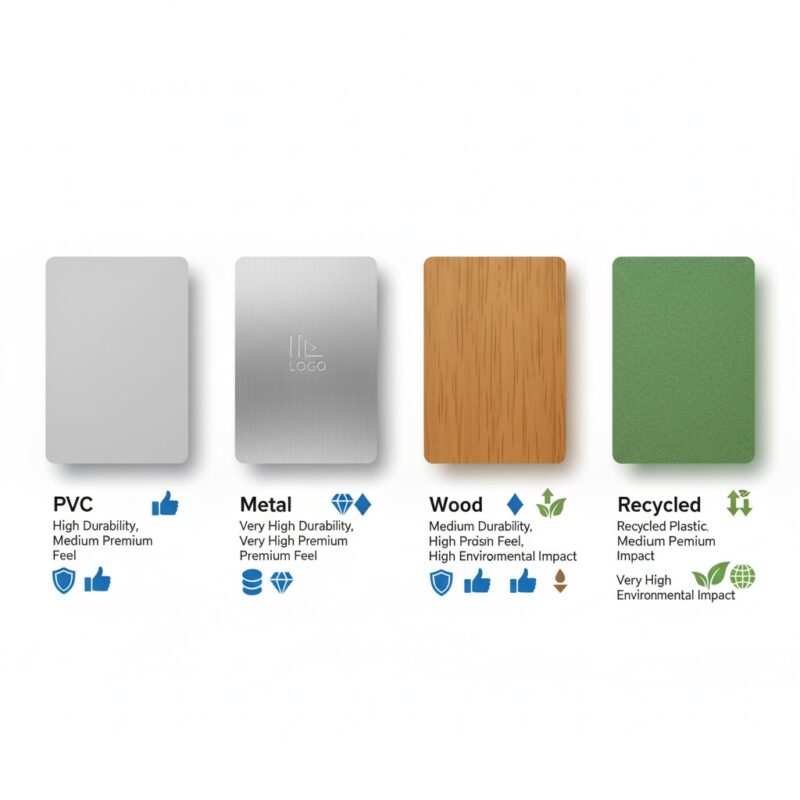
| Material | Durability | Premium Feel | Environmental Impact | Best For |
|---|---|---|---|---|
| PVC | High | Medium | Low | Everyday professional use, large teams |
| Metal | Very High | Very High | Medium (recyclable) | Executives, luxury brands, high-end services |
| Wood | Medium | High | High (sustainable sources) | Eco-conscious brands, creatives, artisans |
| Recycled Plastic | High | Medium | Very High | Green companies, modern tech brands |
What Common Design Mistakes Should I Avoid?
Even the best technology can be undermined by poor design. Here are the most common mistakes I see and how you can steer clear of them.
- Mistake 1: Overcrowding the Card. The number one error is trying to fit too much information on the physical card.
- The Fix: Trust your digital profile. Keep only your name, title, and logo on the front. Let the tap/scan feature handle the rest. It’s that simple.
- Mistake 2: Poor Contrast and Tiny Fonts. A beautiful design is useless if it’s unreadable.
- The Fix: Use a contrast checker for your colors and keep fonts at 7pt or larger. When in doubt, print a draft on paper to test its legibility.
- Mistake 3: Using a Static QR Code. This locks your QR code to a single, unchangeable link forever.
- The Fix: Always use a dynamic QR code. It gives you the flexibility to update your link in the future without reprinting your cards.
- Mistake 4: No Clear Call to Action. You can’t assume everyone knows what an NFC card does.
- The Fix: Add a simple instruction on the back, like “Tap or Scan.” An icon can also help guide the user.
- Mistake 5: Neglecting the Digital Profile. The physical card is just the beginning of the journey.
- The Fix: Spend time making your digital landing page professional, mobile-friendly, and easy to navigate. This is where you make the lasting impression.
- Mistake 6: Ignoring Material Limitations. My first batch of metal NFC cards had read failures because I didn’t account for proper chip positioning.
- The Fix: I learned the hard way that metal blocks NFC signals. If you want a metal card, you must use a provider that understands how to engineer it with proper isolation for the chip. Always confirm this with them before ordering.
Avoiding these common errors sets you up for success.
Can I Print on My Own NFC Cards? Technical Considerations
Yes, you can print on NFC cards, but the material and method matter.
- Card Materials: The most common material is PVC (like a credit card), which is durable and easy to print on. You can also find cards made of wood, metal, or recycled plastic.
- Pre-encoded vs. Blank Cards: You can buy pre-encoded NFC cards that are already linked to a digital business card platform, or you can buy blank NFC cards and program them yourself. I program NFC tags using NFC Tools Pro, and we have complete guides on how to program an NFC card on Android and iPhone.
- NFC Chip Types: Most providers use high-quality chips like the NTAG213, NTAG215, or NTAG216. You don’t typically need to choose this yourself, but NTAG216 chips offer more memory. However, a simple URL link for a digital profile works perfectly on all common chip types.
- Printing Methods: Professional printers use methods like digital, offset, or thermal printing to apply designs to NFC cards. I generally don’t recommend trying to print on a thick PVC card with your standard home office printer.
- Durability and Coating: Ask for a protective coating (like a matte or gloss finish) to protect the printed design from scratches and wear over time.
Choosing your material is one thing; choosing your provider is another.
How Do I Choose the Right NFC Business Card Provider?
The market is full of options, from budget-friendly platforms to premium custom card makers. Here’s what you should consider when choosing a partner, especially if you’re looking for the best digital business card platforms for teams.
- Platform Software: Does their digital profile software meet your needs? Look for features like analytics, CRM integration (like Salesforce or HubSpot), and customization options for your landing page. Current platforms like Wave Connect (V3.0) and Popl (XL series) offer advanced analytics.
- Material Quality and Options: Look at the range of materials they offer. Do they have the plastic, metal, or wood finish you want? Check reviews and provider roundups of the best NFC business cards for feedback on card durability and print quality.
- Customization vs. Templates: Some providers (like Popl or Linq) offer excellent template-based designs, which are fast and easy. Others specialize in fully custom designs from your own artwork. Decide which path fits your brand and budget.
- Pricing Models: Understand the cost. Is it a one-time purchase for the card? Is there an optional or required subscription for advanced software features? You should calculate the long-term cost before committing.
How Much Do NFC Business Cards Cost? A 2025 Price Breakdown
The investment in an NFC business card varies. Here’s a breakdown of what you can expect to pay in 2025.
Price Ranges by Material (Single Card)
- Standard PVC Cards: $5 – $25
- Premium Metal Cards: $40 – $120+
- Eco-Friendly Wood & Recycled Cards: $20 – $50
Long-Term Cost: NFC vs. Traditional Paper Cards
While the upfront cost of an NFC card is higher, the long-term value is significant. Let’s compare a mid-range NFC card to traditional paper cards over two years for a professional who networks frequently.
Scenario: 2-Year Cost Comparison
- NFC Business Card:
- One-time card purchase: $30
- Optional pro subscription for analytics ($5/month): $60/year x 2 years = $120
- Total 2-Year Cost: $150
- Traditional Paper Cards:
- Initial box of 500 premium cards: $60
- Reprint due to running out or a change in details (once per year): $60 x 2 = $120
- Total 2-Year Cost: $180 (plus the environmental cost [3])
In this scenario, the NFC card is not only more dynamic and sustainable but is also more cost-effective over time.
Once you have your card, it’s time to think about security.
Are NFC Business Cards Secure?
Yes, they are extremely secure. It’s helpful to dispel some common myths.
- One-Way Information: NFC is a one-way communication tool in this context. The card sends information to a phone; it cannot pull or “steal” information from the phone.
- Extremely Short Range: NFC’s biggest security feature is its range. A phone must be within 1-2 inches of the card for a connection to happen, a topic we cover in our guide to NFC tag reading distance. Accidental taps are virtually impossible.
- No Personal Data on the Chip: The NFC chip does not store your contact information directly. It only stores a URL link. If you were to lose your card, no one could access sensitive data from the chip itself, and you can simply deactivate the link from your online account.
Security is sorted. Let’s focus on the fun part: tailoring your card to your specific industry for maximum impact.
Real-World Examples: NFC Cards by Industry
A great NFC card is not one-size-fits-all. Here’s how you can optimize your card and digital profile.
For the Real Estate Agent
- Physical Card: A clean, high-end design with a professional headshot on the front.
- Digital Profile: The tap/scan should lead to a page with links to:
- Current listings (with photo galleries)
- A mortgage calculator
- A link to schedule a viewing
- Client testimonials
- Case Study in Action: When I redesigned business cards for a real estate firm in 2024, switching to dynamic QR codes was a game-changer. It allowed them to update their landing page weekly with new featured properties without reprinting a single card, saving them hundreds in printing costs over the year.
For the Software Developer
- Physical Card: A minimalist, perhaps even quirky design. You could include a line of code or a dark-mode theme.
- Digital Profile: The tap/scan should direct to:
- A link to their GitHub profile
- A portfolio of completed projects
- Their resume or CV for download
- A link to their tech blog
For the Creative Professional (Artist/Designer)
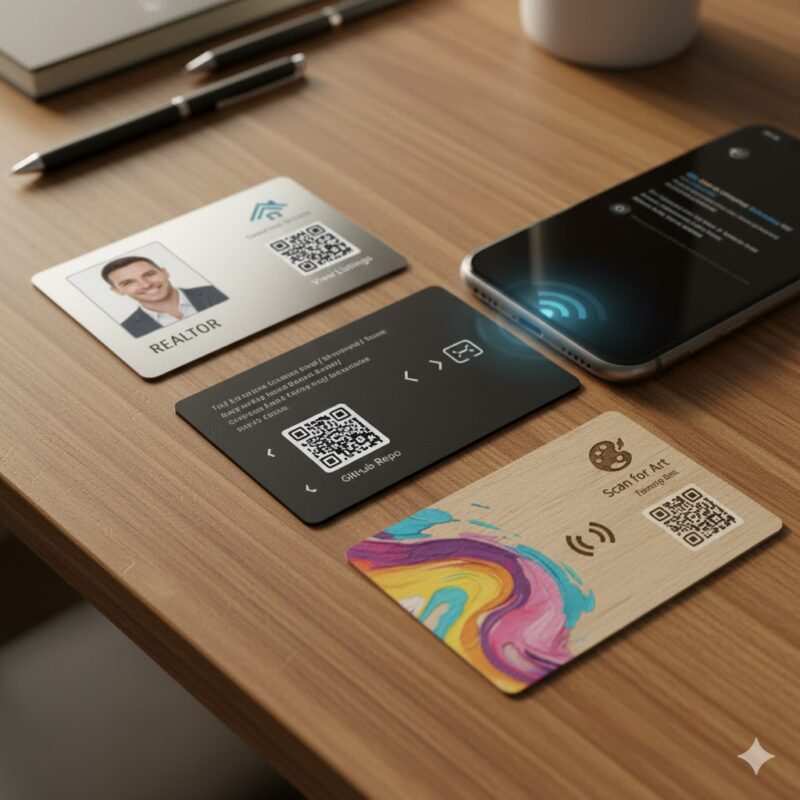
- Physical Card: The card itself is a portfolio piece. Use creative materials, unique typography, and a stunning visual design.
- Digital Profile: The tap/scan is a gateway to their work:
- A link to their high-resolution online portfolio (e.g., Behance, Dribbble)
- Their Instagram or Pinterest profile
- A “Hire Me” contact form
- A link to their online print shop
These examples show that the real power is in optimizing the destination. Let’s dive deeper into making that digital landing page perfect.
Optimizing Your Digital Landing Page
The physical card is just the key; your digital profile is the room you are inviting them into. A poorly designed landing page can ruin a great first impression. You can even build your own with one of these no-code landing page builders.
- Profile Page Essentials: Your page should load instantly and include a professional headshot, your name and title, a brief bio, and clearly organized links. Most importantly, include a “Save Contact” or “Add to Contacts” button that lets users download your vCard (.vcf) file for easy contact export. Consider linking to your Google Business Profile to leverage your card for review generation, a key strategy for enhancing business growth in 2025.
- Mobile-First is Non-Negotiable: Over 99% of people will be viewing your page on a smartphone. Design and test it exclusively for a mobile experience. Ensure buttons are large enough to tap easily and text is easy to read.
- Enable Mobile Wallet Integration: Modern platforms allow contacts to save your digital business card directly to their Apple Wallet or Google Wallet. This keeps your card easily accessible on their phone, dramatically increasing the chances they’ll refer back to it.
- Analytics and Tracking: Integrating your digital card with a CRM increases lead management efficiency by 63% [2]. For example, after helping a client add a prominent “Save Contact” button to their digital profile, we saw a 35% increase in the number of contacts saved directly from their card within the first month. You can even automate sending new contacts to HubSpot to streamline your workflow.
With all this information, you might still have some specific questions.
Frequently Asked Questions (FAQ)
Can you update the information on an NFC card?
Yes! The card itself only stores a link to your digital profile. You can log in and update that profile anytime, and the card will automatically share the new information on the next tap or scan.
How long do NFC business cards last?
The physical NFC chip inside has a data retention of over 10 years and can handle more than 100,000 taps. The card’s lifespan is determined by its material (plastic, metal, etc.) and how well you care for it.
Are NFC cards an eco-friendly alternative to paper?
Absolutely. Because a single NFC card can be used for years and its information updated digitally, it serves as a sustainable business card that dramatically reduces paper waste (88% of paper cards are thrown out in under a week [3]) and your carbon footprint.
Can my digital card be added to Apple Wallet or Google Wallet?
Yes, most modern digital business card platforms support mobile wallet integration. This allows your contacts to save a pass with your information directly in their phone’s native wallet app for easy access.
What is a vCard and why is it important?
A vCard is the standard file format for an electronic business card. Including a vCard download link on your digital profile is crucial because it allows people to save all your contact details into their phone’s address book with a single tap, ensuring accuracy and convenience. For advanced users, we show you how to write a vCard file directly to your NFC tag.
What’s the difference between NTAG213, NTAG215, and NTAG216 chips?
These are common types of NFC chips. The main difference is memory capacity. For a full technical comparison, see our NTAG213 vs. NTAG215 vs. NTAG216 guide. For linking to a digital business card profile, any of these chips work perfectly fine, so it’s not something you need to worry about.
Conclusion: Key Takeaways for Your Design
Designing an effective NFC and QR business card is about blending minimalist design with powerful technology. To create a successful networking tool for yourself, remember these key principles:
- Front of Card: Keep it minimal and brand-focused. Your logo, name, and title are all you truly need. Let your brand breathe.
- Back of Card: Make it clear and actionable. A large, centrally placed QR code and a simple “Tap or Scan” instruction are essential for user engagement.
- Use Both Technologies: Always include both an NFC chip and a Dynamic QR Code. This guarantees that everyone you meet can connect with you, regardless of their phone.
- Focus on the Destination: Your digital profile is where the real connection happens. Ensure it is polished, mobile-friendly, and makes it easy for people to save your contact information.
By following this guide, you can create a modern, professional, and highly effective business card that elevates your networking and leaves a memorable, tech-savvy impression. For more inspiration on the potential of this technology, exploring different NFC digital business card examples can be beneficial.
Meet Oladepo Babatunde, a technical writer and researcher who makes digital business cards easy to use in the real world. As the founder of CardAdviceHub.com, Oladepo turns tap‑to‑connect tech into clear, reliable workflows—covering NFC/QR setup, troubleshooting, platform comparisons, and practical design tips. He draws on a Higher National Diploma in Computer Science and more than a decade of writing experience since 2014 to test cards, apps, and accessories hands‑on, then share step‑by‑step guides with screenshots, checklists, and templates you can follow in minutes. When he’s not filming tutorials, he’s building resources that help solo creators and teams launch faster—no code required. CardAdviceHub focuses on informational how‑tos and does not publish financial advice.
Areas of focus: NFC tags and chips (NTAG213/215/216), iPhone/Android setup, QR best practices, platform integrations (Sheets, HubSpot, Zapier), event signage and accessories.
How I test: Real devices, repeated tap/read tests with different cases/materials, screenshots and videos for every step, and “first‑try” reliability checks.
Editorial standards: Every how‑to is reproducible, updated when apps change, and clearly labels any affiliate relationships. No financial advice.
Contact: info@cardadvicehub.com (or contact us)
